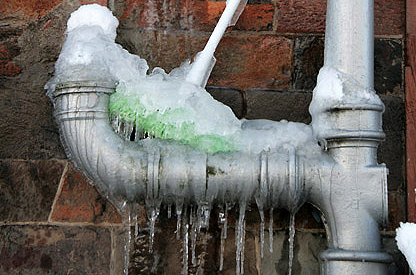Shielding Pipes from Freezing Issues: Critical Strategies
Shielding Pipes from Freezing Issues: Critical Strategies
Blog Article
The content on the next paragraphs on the subject of Preventing and dealing with frozen pipes is highly remarkable. You should take a look.

Winter can damage your plumbing, specifically by freezing pipelines. Here's just how to avoid it from occurring and what to do if it does.
Introduction
As temperatures decline, the risk of frozen pipes rises, potentially bring about costly repair work and water damages. Understanding how to stop frozen pipelines is important for home owners in chilly climates.
Prevention Tips
Protecting at risk pipes
Cover pipelines in insulation sleeves or make use of heat tape to protect them from freezing temperatures. Focus on pipes in unheated or outside locations of the home.
Home heating methods
Keep interior spaces effectively warmed, specifically locations with pipes. Open closet doors to enable cozy air to circulate around pipes under sinks.
Exactly how to determine frozen pipes
Search for decreased water flow from taps, uncommon smells or noises from pipes, and noticeable frost on revealed pipes.
Long-Term Solutions
Architectural modifications
Consider rerouting pipelines far from exterior wall surfaces or unheated areas. Include extra insulation to attics, basements, and crawl spaces.
Updating insulation
Invest in top notch insulation for pipelines, attics, and wall surfaces. Proper insulation aids keep consistent temperature levels and decreases the risk of icy pipelines.
Securing Outdoor Pipes
Garden hoses and exterior taps
Disconnect and drain pipes garden pipes before winter season. Mount frost-proof spigots or cover exterior taps with insulated caps.
Recognizing Icy Pipes
What creates pipelines to freeze?
Pipelines freeze when exposed to temperature levels listed below 32 ° F (0 ° C) for prolonged durations. As water inside the pipes ices up, it expands, taxing the pipe wall surfaces and possibly triggering them to break.
Dangers and problems
Frozen pipes can bring about water supply disturbances, building damage, and costly repair work. Burst pipelines can flood homes and trigger comprehensive structural damages.
Indicators of Frozen Water Lines
Recognizing icy pipes early can avoid them from rupturing.
What to Do If Your Pipes Freeze
Immediate actions to take
If you think icy pipelines, keep taps open to relieve pressure as the ice thaws. Make use of a hairdryer or towels taken in warm water to thaw pipelines gradually.
Verdict
Preventing icy pipelines calls for aggressive procedures and quick reactions. By understanding the reasons, signs, and preventive measures, home owners can shield their plumbing throughout winter.
5 Ways to Prevent Frozen Pipes
Drain Outdoor Faucets and Disconnect Hoses
First, close the shut-off valve that controls the flow of water in the pipe to your outdoor faucet. Then, head outside to disconnect and drain your hose and open the outdoor faucet to allow the water to completely drain out of the line. Turn off the faucet when done. Finally, head back to the shut-off valve and drain the remaining water inside the pipe into a bucket or container. Additionally, if you have a home irrigation system, you should consider hiring an expert to clear the system of water each year.
Insulate Pipes
One of the best and most cost-effective methods for preventing frozen water pipes is to wrap your pipes with insulation. This is especially important for areas in your home that aren’t exposed to heat, such as an attic. We suggest using foam sleeves, which can typically be found at your local hardware store.
Keep Heat Running at 65
Your pipes are located inside your walls, and the temperature there is much colder than the rest of the house. To prevent your pipes from freezing, The Insurance Information Institute suggests that you keep your home heated to at least 65 degrees, even when traveling. You may want to invest in smart devices that can keep an eye on the temperature in your home while you’re away.
Leave Water Dripping
Moving water — even a small trickle — can prevent ice from forming inside your pipes. When freezing temps are imminent, start a drip of water from all faucets that serve exposed pipes. Leaving a few faucets running will also help relieve pressure inside the pipes and help prevent a rupture if the water inside freezes.
Open Cupboard Doors
Warm your kitchen and bathroom pipes by opening cupboards and vanities. You should also leave your interior doors ajar to help warm air circulate evenly throughout your home.

As a devoted reader about Prevent Frozen Pipes , I thought sharing that piece was really useful. Sharing is nice. You just don't know, you could be doing someone a favor. Kudos for your time. Return soon.
Schedule Today! Report this page